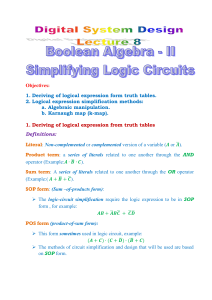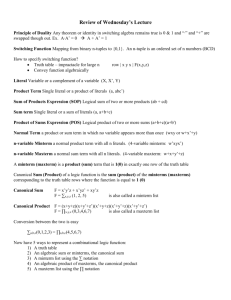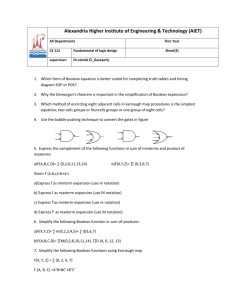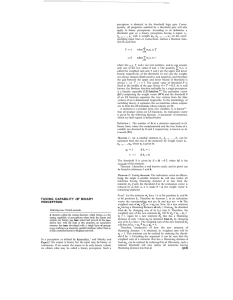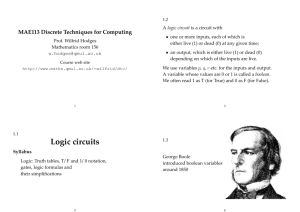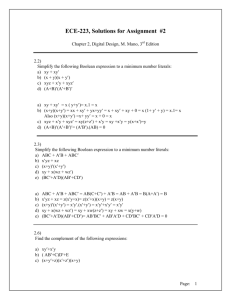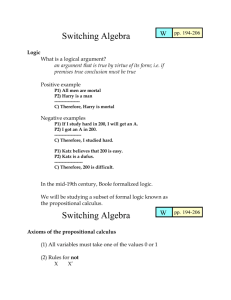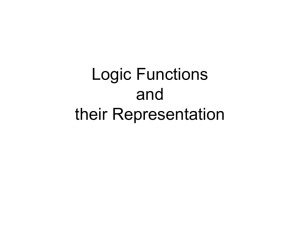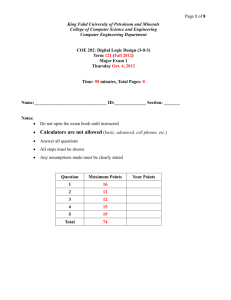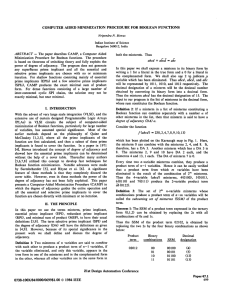ALGORITHM FOR LEARNING REPRESENTATIONS IN BOOLEAN NEURAL NETWORKS
advertisement
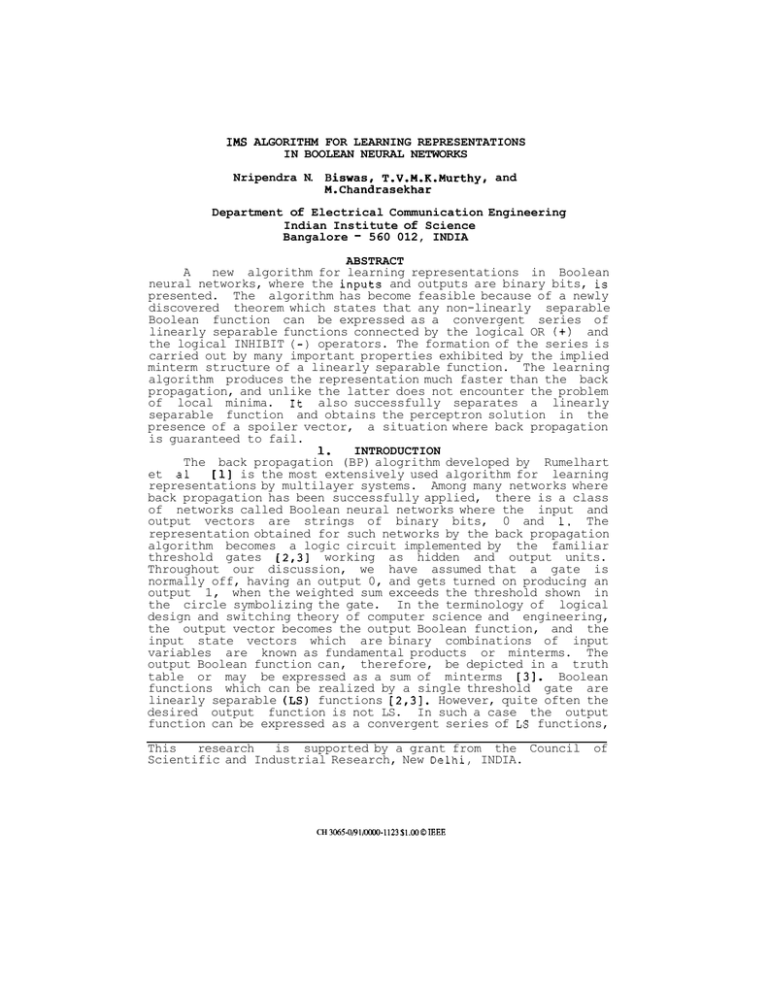
IMS ALGORITHM FOR LEARNING REPRESENTATIONS
IN BOOLEAN NEURAL NETWORKS
Nripendra N. Biswas, T.V.M,K.Murthy,
M.Chandrasekhar
and
Department of Electrical Communication Engineering
Indian Institute of Science
Bangalore - 560 012, INDIA
ABSTRACT
A
new algorithm for learning representations in Boolean
neural networks, where the inpdts and outputs are binary bits, is
presented. The algorithm has become feasible because of a newly
discovered theorem which states that any non-linearly separable
Boolean function can be expressed as a convergent series of
linearly separable functions connected by the logical OR ( + ) and
the logical INHIBIT ( - ) operators. The formation of the series is
carried out by many important properties exhibited by the implied
minterm structure of a linearly separable function. The learning
algorithm produces the representation much faster than the back
propagation, and unlike the latter does not encounter the problem
of local minima. It also successfully separates a linearly
separable function and obtains the perceptron solution in the
presence of a spoiler vector, a situation where back propagation
is guaranteed to fail.
1.
INTRODUCTION
The back propagation (BP) alogrithm developed by Rumelhart
et a1
[l] is the most extensively used algorithm for learning
representations by multilayer systems. Among many networks where
back propagation has been successfully applied, there is a class
of networks called Boolean neural networks where the input and
output vectors are strings of binary bits, 0 and 1. The
representation obtained for such networks by the back propagation
algorithm becomes a logic circuit implemented by the familiar
threshold gates [2,3] working as hidden and output units.
Throughout our discussion, we have assumed that a gate is
normally off, having an output 0, and gets turned on producing an
output 1, when the weighted sum exceeds the threshold shown in
the circle symbolizing the gate. In the terminology of logical
design and switching theory of computer science and engineering,
the output vector becomes the output Boolean function, and the
input state vectors which are binary combinations of input
variables are known as fundamental products or minterms. The
output Boolean function can, therefore, be depicted in a truth
table or may be expressed as a sum of minterms [31. Boolean
functions which can be realized by a single threshold gate are
linearly separable (LS) functions [2,3]. However, quite often the
desired output function is not LS. In such a case the output
function can be expressed as a convergent series of LS functions,
This
research
is supported by a grant from the Council
Scientific and Industrial Research, New Delhi, INDIA.
CH 3065-0/91/woo-1123 51.00 QIEEE
of
given by a new theorem (The Linerization theorem) stated in this
paper. Based on this theorem and the implied minterm structure
151 of LS functions, a new learning algorithm for Boolean neural
networks has been developed.
Theorem 1 : (TheLinearization Theorem) A non-linearly separable
Boolean function F can always be expressed as a convergent series
of linearly separable (LS) functions F , F2,
F
connected by
Bperators , such
the logical OR ( + ) and the logical INHiBIT ( - 1
that,
F1 > F2->
> F , and
F = F
F2 +
."+ Fn when n is odd, and
F = F1 - F +
- F when n is even.
The proof 8f this thehem has been given in [ 41.
2.
IMPLIED MINTBRM STRUCTURE
We assume that the reader is familiar with some of the basic
terms of switching theory, such as the on-minterms, off-terms,
dc-minterms, linearly separable(LS) function. We also assume that
the reader is also familiar with the definitions and workina of a
threshold gate and the ass.ociated terms, such as wei ht vector,
weighted sum, upper and lower bounds of threshold*
r m tion v e c t o G f an LS function.
Definition 1 : The tabular form of a given function is the onminterms written in their b G y form. It may also be considered
as a matrix where each row represents a minterm whose output is
desired to be 1, and each column is headed by a variable. For
example, the tabular form of a 4- variable function is shown in
table I(a).
Definition 2: A Boolean function is called positive
ordered,
if in every column of the tabular form of the given function, the
number of 1s is not less than the number of Os, and the ratios of
are
the number of 1s to that of 0 s are such that if r. and r
these ratios of the ith and the jth columns respe&tively,J then
r. 2 r. when j > i. Here, the ith column is towards the right. of
tile jth column, and columns are counted from right to left, that
is, the rightmost column is the first column.
An arbitrary Boolean function can be made positive and
ordered by suitable permutations and/or complementations of the
columns of its tabular form.
Definition 3 : A linearly separable function which is positive
and ordered will be called a positive ordered g (POLS) function.
In a POLS function, it has been shown [2,3,51 that if a
minterm m is realized by a set of weights and threshold, then
there areiminterms which will also be realized by the same set.
If m. is one such minterm, then mi is said to imply m.. In a
POLS $unction the implied minterm m. is obtained from the3 implying minterm m. by either unit postihve permutation or by elementary positive'complementaion.
These terms have been explained in
[4,5]. Also, note that the implication relation is transitive.
For this reason, all the minterms of a POLS function form a
graphical structure where the implication relations between them
are shown. Such a structure is called an implied minterm structure [IMS]. A detailed and brief discussion about the IMS can be
found in [ S ] and [41 respectively. A modular structure very
...
...
..
...
.
1124
(b)
(a)
mi
x3
3
0
4
1
5
1
7
0
1
9
1 0
13
1
1
1 4 1 1
1
1
15
wherein
x4
0
0
0
x2 x1 mi
1
1
8
5
0
0
1 1 3
0
1
1 1 2
0 1 1 1
0
1 1 5
1 0
6
1
1
1 4
the
x1
1
0
1
1
1
1
0
1
x3
x4
x12
0
0
0
1
1
1
0
1
1
1
0
0
0
1
1
1
1
1
1
0
1
1
0
0
column x2 has been complemented and the columns
x' become the 4th, 3rd, 2nd, and 1st columns re~ $ ~ % % ~ n ~ f T a h e I (b) The TRANSFORM transforms the function
F to a new function G. It also changes the decimal designations
of the minterms. Note that the least minterm of Table I(a),that
is of F,is 3, and that of Table I(b),that is of G , is 5. This is
the highest decimal designation of the least minterm that may be
obtained. The TRANSFORM procedure ensures that the series of the
linearization theorem is formed by a minimal number of terms.
This in turn results in producing a minimal number of hidden
units in the learnt representation. The transformed minterms are
.
stored in an array called the set of transformed minterms(ST0M).
Now, we subject these transformed on-minterms to the REALIZE
procedure, which starts with computing the first LS function of
First, identify the unimplied
the series of G, that is, G
minterms in the transformed tabular form. These terms are stored
in an array called the set of unim lied minterms(SUM). The set of
unimplied minterms, SUM;foFG,*the
IMS of Fig 1)
.
5 : O l O
8 : l - 0
-
In Fig 1,
in squares.
positive and
Its existence
weights. Hence
l
the on-minterms of G are circled, and the UMs are
G is a POLS function, its weights are all
orderes. NOW, detect 10 combinations in the UMs.
indicates inequalities among two
successive
5 and 8 give the Weight Vector Inequalities as
w. > w, > w- = W.
From this, let th8 weigh$ vectoi! variables be
c b a a
We now solve for the unknown weights c l b r aand the upper bound of
threshold of G1 by solving the required number of simultaneous
equations.
As
soon as we know the ordered
weight vector
variables
determined from the SUM, we know the exact number of
independent equations required to find the unknowns of the
realization vector, RV, namely the values of each of the weight
upper bound of threshold T. Next we identify
variables anthe border minterms, which are defined as follows.
Definition
5 : A minterm satisfying the following two relations
is called a Border Minterm(BM1. (a) It is neither directly nor
distantly implied by any of the minterms of the SUM. (b) Each one
of its directly implied minterms is either a UM or a minterm
directly or distantly implied by at least one of the minterms of
the SUM.
Fig.1 shows the two BMs 3 and 4 (in triangles) for the
function G1.
It is known from the property of a threshold gate that the
weighted sum of some of the UMs will be equal to the upper bound
of the threshold T, and the weighted sum of some of the BMs will
be equal to the lower bound of threshold,t. We now make a conjecture that there always exists p number of UMs each of whose
weighted sum is exactly e ual to T, and 9 number of BMs each of
whose weighte-hsum 1 s ex&
equa tot, andp+q>greG
01:
equal to the exact number of independent equations required to
solve for the weight vector variables and T. Again,in our algorithm the weights are minimum integers as can be obtained from
the Dertouzous table[71. Therefore, the minimum gap between two
weights is always 1. Hence the gap between the lower bound and
the upper bound of the threshold, T - t = 1, that is, t=T-1.
Definition 6 :
Unimplied and border minterms whose weighted sums
are exactly equal to the upper and lower bounds respectively of
threshold, will be called distinguished UMs(DUM), and
distinThe set of DUM and DBM
found by an exhausguished =(DBM).
tive search among the UMs and BMs whose number is usually
not
-
AS
--
- --
are
1126
very large. For function G1 the DUMs 5 and 8 and the DBMs 3 and
4 give the four independent realization vector equations (RVE)
-
[
1
0
0
1
1 -1
0 -1
2 -1
0 -1
-
I!]
-1
yielding
the
solution
[i]
As the gap between T and t is always 1, the actual threshold
is fixed at the middle of the gap, that is, 8 = T - 0.5.
Consequently, the RV becomes, ( < 3 2 1 1 > 2.5)
After RV has been computed, all the minterms greater than
the least minterm are tested if they are realized by the realization vector(RV). During this process if any minterm which is not
an on-minterm of the transformed function (circled in the IMS of
Fig 1) is realized, then it is stored in an array called the set
For G1 this SEM turns out to be
of error minterms(SEM).
{ 7 , 9, 10) shown by * I s in Fig 1.
SEM (G ) =
Note that the’ checking for the realization need not go
beyond 12(1100), since in this minterm all its Is form a single
string of consecutive 1s at the extreme left. It is obvious that
when such a minterm is realized, any minterm which is larger than
this will also be realized. Clearly, the function which has all
the starting on-minterms and also the set of error minterms is an
G..
LS function and is the first function of the series,
.
I
G
= z(5-15)
Thereforelthe realiza4ion vector, RV, of G1 is given by
( < 3 2 1 1 > 2.5 )
Note
that while finding the LS function Giwe had to
add
the
set of error minterms to the set of on-minterms of G1.
These, therefore, must be subtracted and we must find the second
function of the series, G2. For this the starting set of minterms is the SEM(G1). This becomes the SOM for the function G
These are once more transformed and stored in STOM only if tie
new transform obtains a larger designation of the least minterm.
Otherwise, the previous transform is not altered. Following the
same procedure as for G
the RV for G is found.
This turns
out to be ((2 1 1 1>2.?ii. Then the SE&(G ) is found. Here it
becomes Ill-15). To cancel the effect of thg newly found SEMI we
compute
another LS function G3 whose on-minterms are the
SEM(G2).
The RV for G3 is determined to be ((3 2 1 1
>3.5).
The
SEM(G3) however turns out to be the null set. Here, the
REALIZE procedure terminates.
The weights and the thresholds of the functions G1, G and
G3 have been computed by the REALIZE procedure.
The REZTORE
procedure now assigns these weights with proper signs to the
input variables, and also calculates the new threshold, following
the standard methods given in [2,8]. The new weights and threshold give us the three LS functions F
F2 and F3, the three terms
of the linearization theorem. These $be
--
.
1127
= (tl 2 -1 3>1.5)
-
((1 1 - 1 2>1.5)
+ (tl 2 -1 3>3.5)
Since F and F are excitory, they are connected to the output
F2 is inhibitory and is therefore connected to
unit by height
the output unit by weight -1. The threshold of the output unit
is always 0.5. The representation learnt is shown in Fig 2.
4 THE SINGLE PERCEPTRoEl SOLU!I!ION
It is obvious that if the algorithm terminates by finding
only one function of the Linearization theorem, then the given
function is itself an LS function. The algorithm now declares the
single hidden unit as the output unit. The representation so
obtained is the single perceptron solution. For example, Fig 3
shows the single perceptron solution found by the IMS algorithm
for example 4 of Brady et a1[91. This problem is interesting as
it has been shown in [9] that back propagation fails to separate
due to the presence of a 'spoiler' vector. Here, our algorithm
has implemented the Boolean function
F(X3tX2rX )=Z(1,6,7) +$X(O,3,5)
where 0, 3, anh 5 are the don't care or dc-minterms.
4.
-
5
C O ~ S I O N S
The algorithm
as presented consists essentially of 3
procedures,
TRANSFORM, REALIZE, and RESTORE. All these three
procedures are non-iterative. Hence, the algorithm will be much
faster than the BP. Unlike BP, the problem of local minima is
non-existent in our algorithm. Therefore, the algorithm is much
faster and will always produce the correct solution. The weights
are
always positive and negative integers(inc1uding zero),
and
like
the Dertouzous Vector [7], they are also minimum
integers. As we have shown in section 4 the same algorithm also
produces
the
single perceptron solution,
and there is no
need for any exclusive perceptron training algorithm [lo]. We
have
observed that there are many problems where the BP takes
hours to train the network and even then may not produce the
correct representation for its being trapped in local minima,
our algorithm takes only
seconds to
produce the correct
solution in a failproof manner.
We hope that
with
further
research and improvement, the IMS algorithm will
ultimately
replace Back Propagation totally in all
artificial neural
networks which are Boolean.
REFEREDJCES
[l] D.E. Rumelhart, G.E. Hinton, and R.J. Williams, in Parallel
Distributed Processing : Explorations in the Microstructures of
coqnition (Eds. Rumelhart and McClelland) , Cambridge, Mass, M E
Press, Vol.1, pp.318-362, 1986.
[2]
P.M. Lewis and C.L. Coates, Threshold Logic, New York,
Wiley, 1967.
[3]
N.N. Biswas, Introduction to Logic and Switchinq Theory,
New York, Gordon and Breach, 1975,
[4]
N.N. Biswas and R. Kumar, "A new algorithm for learning
representations in Boolean neural networks", Current Science,
Vo1.59, No.12, pp.595-600, 25 June 1990.
1128
151
A.K. Sarje and N.N. Biswas, "Testing threshold functions
using implied minterm structure", International Journal of Systems Science, Vo1.14, pp.497-512, 1983.
[6] H.C. Torng, "An approach for the realization of linearly
separable switching functions", IEEE Trans of Electronic Computers, Vol.EC-15, pp.14-20, 1966.
[71 M.L Dertouzous,
Threshold Logic: A synthesis approach,
Research Monograph No. 32, Cambridge, MA, USA, The MIT Press
1965.
[8]
2. Kohavi, Switchinp and Finite Automata Theory, 2nd Ed.,
New York, McGraw-Hill, .
8
7
9
1
[9] M.L.Brady, R.Raghavan, and J.slawny, "Back Propagation fails
to separate where perceptrons succeed" IEEE Trans on Circuits
and Systems", Vo1.36, No.5, pp 665-674, May 1989.
[lo] P.D.Wasserman
Neural Computing: Theory and Practice, New
York, Van Nostrand Reinhold, 1989.
-
-
-
FIGURES
Fig.2
1129
